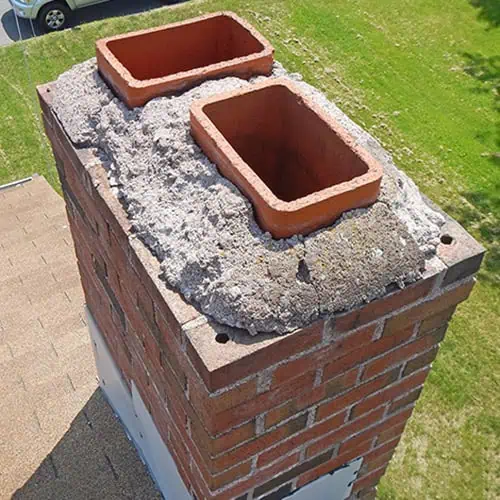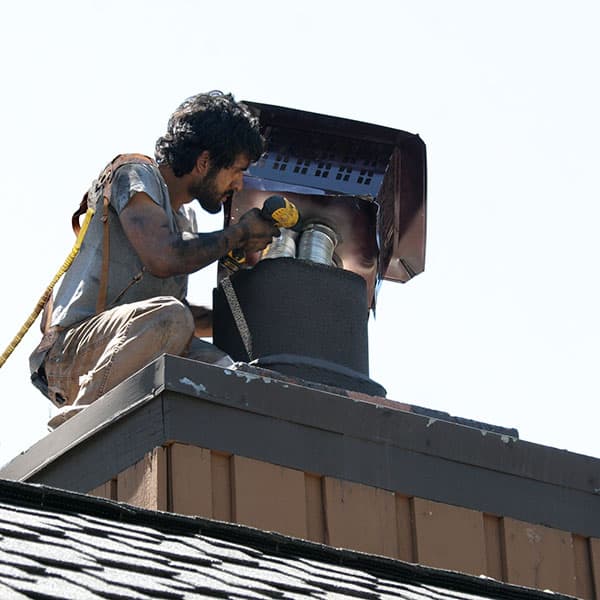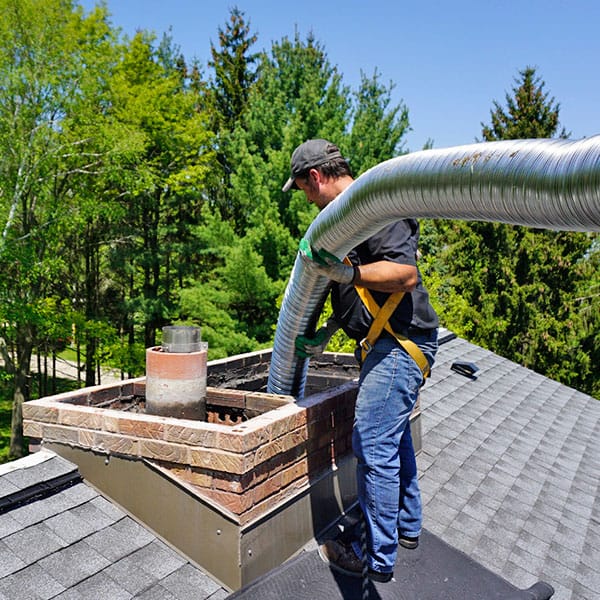Essential guide to chimney liner installation in Plymouth County - covering safety requirements, restoration benefits, and choosing the right solution.
Share:

Most chimneys built before the 1980s in Norfolk County and Plymouth County lack proper liner systems. Back then, builders relied on clay tiles or simply left flues unlined. Those clay tiles crack over time, especially with our freeze-thaw cycles.
When your liner fails, combustion gases don’t vent properly. Carbon monoxide can seep into your home. Creosote builds up in damaged areas, creating fire risks. The chimney structure itself starts deteriorating from the inside out.
Massachusetts building codes now require specific liner types for different heating systems. If you’re selling your home or filing an insurance claim, you’ll likely need compliant liner installation to move forward.

You don’t need to guess whether your chimney liner needs attention. The signs are usually pretty clear once you know what to look for.
White staining on your chimney exterior means moisture is getting through damaged liner sections. That’s efflorescence – mineral deposits left behind when water evaporates. It tells you the liner isn’t keeping combustion byproducts contained where they belong.
Draft problems are another red flag. If smoke enters your room instead of going up the chimney, if your fireplace doesn’t draw well, or if you smell smoke or gas odors, your liner system isn’t functioning properly.
Rust on your damper or firebox components indicates moisture infiltration. A properly functioning liner prevents this moisture from condensing inside your chimney system. When you see rust, it means the liner has failed somewhere along the line.
Cracked or damaged crown and cap areas often develop because liner problems allow moisture and gases to attack the masonry from inside. What looks like an exterior problem frequently starts with interior liner failure.
During professional inspections, we often find spalling bricks or deteriorated mortar joints inside the flue. This damage happens when acidic combustion byproducts attack unprotected masonry surfaces. A proper liner prevents this chemical attack.
Stainless steel liners handle most residential applications in Plymouth County. They resist corrosion, install relatively quickly, and work with gas, oil, and wood-burning systems. You’ll pay more upfront than clay alternatives, but they last decades with minimal maintenance.
Clay tile liners cost less initially but crack easily in our climate. They work fine for wood-burning fireplaces if properly installed and maintained. However, they’re not suitable for modern high-efficiency heating systems that produce acidic condensation.
Cast-in-place liners work well for oddly shaped or damaged chimneys where traditional liner installation isn’t feasible. We pour a cement-like mixture around a form, creating a custom liner that conforms to your specific flue dimensions. This option costs more but solves complex restoration challenges.
Aluminum liners work for certain gas appliances but have limited applications. They’re less expensive than stainless steel but can’t handle the temperature and corrosion demands of oil or wood systems.
Your heating system type determines liner requirements. High-efficiency gas furnaces produce acidic condensation that requires specific stainless steel grades. Wood stoves need liners rated for higher temperatures. Oil systems fall somewhere in between but still require corrosion-resistant materials.
The size matters too. Liner diameter must match your appliance requirements for proper draft and safety. Oversized liners don’t draft properly. Undersized liners create dangerous pressure situations.
Professional liner installation starts with thorough inspection and measurement. We need exact flue dimensions and condition assessments before ordering materials. We’ll also evaluate your heating system requirements to specify the right liner type and size.
Most installations take one to two days, depending on complexity and access challenges. The process involves removing old liner materials if present, preparing the flue surfaces, and carefully installing the new liner system with proper connections and insulation where required.
Weather affects scheduling since we work partially on your roof. Plan for potential delays during winter months or extended rainy periods common in our coastal Massachusetts climate.

Chimney liner installation costs in Plymouth County typically range from $2,500 to $7,000, depending on several factors. Chimney height affects pricing since taller chimneys require more materials and labor time. Accessibility matters too – chimneys with difficult roof access or tight interior spaces cost more to line.
Liner type significantly impacts cost. Basic stainless steel liners cost less than premium grades designed for specific applications. Cast-in-place systems cost the most but solve problems other liners can’t address.
Insulation requirements add to the total investment. Some installations need insulation around the liner for proper clearances and performance. This adds material costs and installation time but improves safety and efficiency.
Existing chimney condition affects pricing. If your flue needs cleaning, repair, or preparation work before liner installation, expect additional costs. However, addressing these issues during liner installation often costs less than handling them separately.
Permit requirements in Norfolk County and Plymouth County add fees but ensure code compliance. We handle permit applications and inspections as part of our service.
Don’t let price alone drive your decision. Cheap liner installation often means corners cut on materials, insulation, or connection details. These shortcuts create safety risks and performance problems that cost more to fix later.
Chimney restoration often centers around liner installation, but the project usually involves additional components. Crown repair, cap replacement, and masonry restoration work together with new liners to create properly functioning chimney systems.
Timing these projects together saves money and reduces disruption. Scaffolding and equipment setup costs get spread across multiple repair tasks. You also avoid repeated roof access and setup fees that come with separate project scheduling.
Many homeowners discover additional needs during liner installation. Damaged flue tiles, deteriorated mortar joints, or structural issues become apparent once we access the interior chimney spaces. Planning for potential additional work helps avoid surprises.
Insurance considerations often drive comprehensive restoration approaches. Many insurance companies require complete chimney system evaluations and repairs rather than piecemeal fixes. Addressing all issues simultaneously can help with coverage and claims processing.
The restoration sequence matters for best results. Crown and exterior masonry work should happen after liner installation to ensure proper sealing and weatherproofing around the new liner system.
Consider your long-term plans when planning restoration work. If you’re staying in your home for many years, investing in comprehensive restoration makes sense. If you’re preparing to sell, focus on safety-critical items and code compliance requirements.
Chimney liner installation isn’t optional when safety is compromised or codes aren’t met. The question isn’t whether you need it, but when and how to get it done right. Focus on finding experienced contractors who understand Massachusetts requirements and can explain your specific situation clearly.
Get multiple opinions if you’re unsure about the scope of work needed. However, don’t let price shopping compromise safety or quality. The lowest bid often means shortcuts that create bigger problems later.
When you’re ready to move forward with chimney restoration or liner installation, we at Above and Beyond Chimney provide the expertise and local knowledge Plymouth County homeowners need for safe, compliant, and lasting results.
Article details:
Share: